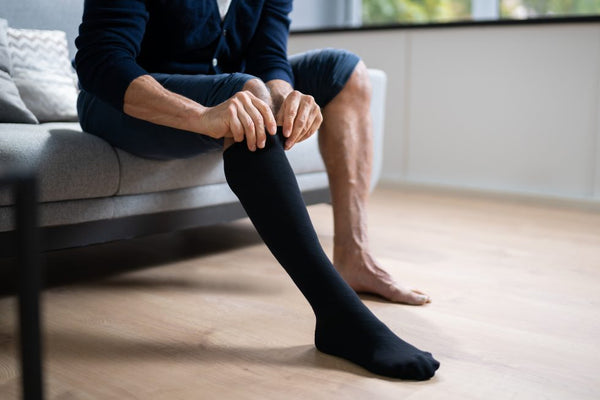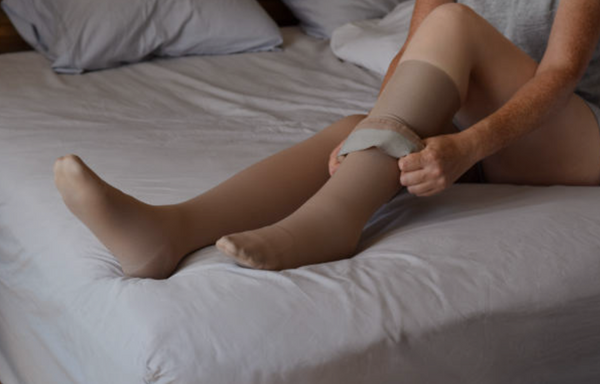
Medically reviewed by Zoe Deol, MD,FACS, DABVLM
Compression socks are gaining attention for their role in supporting leg health and improving blood circulation.
They apply gentle pressure to your legs, so they are effective in various scenarios, from medical use to everyday wear:
This article explains what compression socks do, how they work, and the beneficial effects they offer across multiple contexts.
Keep reading below.
Compression socks work by applying graduated pressure to your legs.
This pressure is measured in millimeters of mercury and is carefully designed to help your leg valves function better.
Here is how they work:
Graduated compression starting at the ankle and up your legs creates a form of compression therapy, which improves leg circulation. The gentle pressure from the socks helps vein valves and supports your calf muscles to promote blood flow back towards your heart.
Remember: Different levels of compression are used depending on the degree of pressure needed for your specific health condition.
This simple mechanism makes a big difference in how your legs feel.

Compression socks offer several health benefits that can make a big difference in your daily life and recovery processes.
Here is what they do for you:

There are three main types of compression socks:
Selecting the right type of compression socks depends on your specific needs and conditions:
Consult a healthcare provider to help you select the correct size and type to maximize the beneficial effects of compression socks without any discomfort.

Compression socks are ideal for a range of people with different health goals:
Wearing the right type of compression socks ensures your legs stay healthy and comfortable, regardless of your activity level.
Remember: While compression socks benefit many, they aren't suitable for everyone, especially people with:
Always consult a health care professional or a vein specialist before starting compression therapy if you have any of these conditions. This ensures safety and avoids any adverse effects from inappropriate use.

When choosing the right compression socks, focus on three key factors: size, style, and compression level.
Here’s how to make the best choice:
Pro tips:
Let’s clear up some myths about compression socks:
Using compression socks correctly can make a real difference in your leg health.
They support circulation, reduce swelling, and can even prevent blood clots and varicose veins.
But remember, the right size and compression level are essential. Always measure carefully and follow your healthcare provider’s advice for the best results.
If you're ready to experience the benefits firsthand, consider our selection at HealthyLegs.com.
You will find options for daily wear, athletic recovery, pregnancy and for medical needs.
Make the smart choice for your legs today!
When should you wear compression socks?
Wear compression socks during long periods of sitting or standing, after surgery to prevent clots, and during exercise if you are doing an intense high-impact workout or are recovering from injuries. Compression socks also work well in pregnancy. They're best to put on in the morning before swelling starts.
What are the benefits of wearing compression socks?
They improve circulation, reduce swelling, and help prevent blood clots and varicose veins. Athletes also wear them to enhance muscle recovery and performance.
Who should not wear compression socks?
Avoid compression socks if you have severe peripheral artery disease, skin infections, or highly sensitive skin. Check with a healthcare provider if unsure.
Should I wear compression socks if I sit all day? Yes, wearing compression socks is beneficial if you sit all day. They help prevent swelling and discomfort by improving blood flow in your legs.
What are the side effects of compression socks?
If worn incorrectly, they can cause skin irritation and discomfort or worsen conditions like peripheral artery disease. Ensure they fit well and are not too tight. Always consult with your physician.
Where does the fluid go when wearing compression stockings?
Compression stockings assist the fluid to move away from the swollen tissues and more efficiently into the lymphatic system and the upper body. Graduated compression can improve blood circulation through the veins preventing fluid from pooling in your legs and causing swelling.
Should you elevate your legs when wearing compression socks?
Elevating your legs while wearing compression socks can enhance their effectiveness because elevation aids in venous return and reduces swelling faster.
Do compression socks help healing?
Yes, they help by maintaining proper blood flow, reducing swelling, and minimizing the risk of clots. These factors are crucial during post-operative recovery or injury healing.
Should I wear compression socks while walking?
Absolutely. Wearing compression socks while walking helps stimulate blood flow, reduces fatigue, and supports your leg muscles during activity.
Is it okay to sleep with compression socks?
Moderate and firm compression socks are especially contraindicated during sleep, though light compression socks may be fine. Generally, you should avoid wearing compression socks to bed unless instructed by a healthcare provider, as they are designed to work against gravity and your muscles’ natural pumping action during movement.